英汉翻译:心理学术语
- 格式:doc
- 大小:51.00 KB
- 文档页数:5

第五页定义“psychology”源于两个希腊词根Psyche”和“Logos”. “Psyche”的意思是“思Logos1991该研究什么和如何进行研究都存在着很大分歧。
心理学史哲学心理学家已经研究过的许多问题早在公元前5世纪就被希腊哲学家苏格拉底、1经验主义---2实证主义---该学派认为应该把科学的方法和原理应用于对人类行为的研究。
生物学生物学对心理学有两个重要影响。
1进化论—于研究和理解行为有很多重要的影响。
2 生理学—解起了关键作用。
物理学•这门学科因为它巨大的成就曾被心理学家们当作理想的模型。
他们曾借鉴物理学的科学方法和原究心理。
19他们的一些学科内容应用于对人1879年通常被说成是心理学作为一门独立的科学学科的开始。
因为在1879年冯特在莱比锡建立了第一个心理学实验室。
虽然冯特因此被称1890121875年他就开始在哈佛大学教授生理学与心理学之间关系的课程。
心理学的发展结构主义--,宣称那些构成心理活动的最基本的感觉单元共有46708功能主义--由詹姆士所提出的方法.是被接下来出现在世纪之交的两种非常有影响的方法代替。
精神分析--实际上是由奥地利的西德蒙德•弗洛伊德发展形成的一种治疗方法。
但是在很多著作中像《梦的解论们察觉不到的过程决定着。
行为主义--主义方法的形式发展起来。
他们认为行为主义忽视了在我们大脑里那些最重要的和最有意义的东西。
认知心理学--目的是通过使用计算机后且成为当今心理学的一支主流。
人本主义方法--体的意识经验和生活目标。
生物学--的有较高级的解释。
第六页心理分析的研究方法1.起源与历史心理分析主要是由在神经病学方面颇有造诣的维也纳医生西蒙﹒弗洛伊德创建并发展起来的。
弗洛伊德对癔症很感兴趣,认为它是非生理原因造成的身体疾病的表现形式,并且他相信不仅是癔症还有其他的紊乱症状甚至是“常态”人格也是由无意识心理原因造成的。
弗洛伊德发展出一种治疗技术,用于治疗由无意识引起的精神错乱。
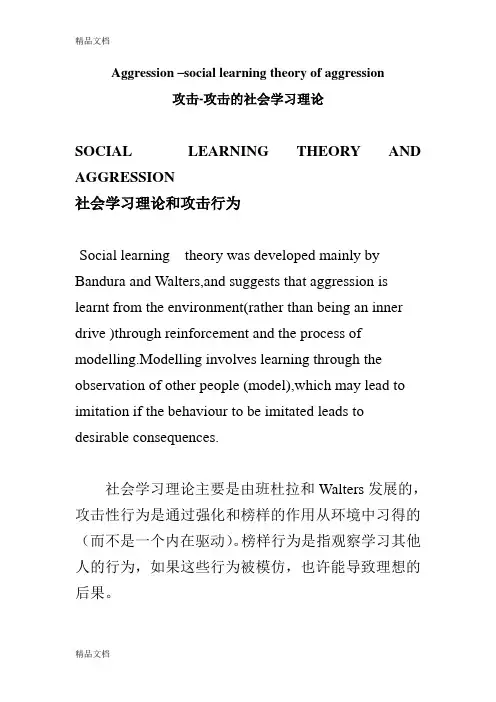
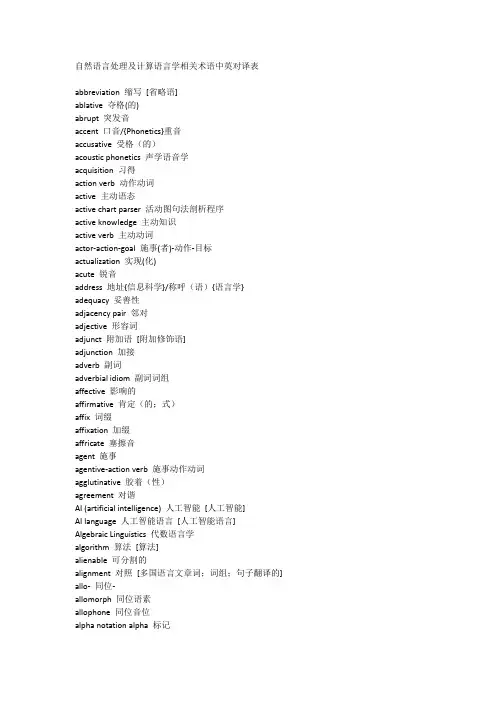
自然语言处理及计算语言学相关术语中英对译表abbreviation 缩写[省略语]ablative 夺格(的)abrupt 突发音accent 口音/{Phonetics}重音accusative 受格(的)acoustic phonetics 声学语音学acquisition 习得action verb 动作动词active 主动语态active chart parser 活动图句法剖析程序active knowledge 主动知识active verb 主动动词actor-action-goal 施事(者)-动作-目标actualization 实现(化)acute 锐音address 地址{信息科学}/称呼(语){语言学} adequacy 妥善性adjacency pair 邻对adjective 形容词adjunct 附加语[附加修饰语]adjunction 加接adverb 副词adverbial idiom 副词词组affective 影响的affirmative 肯定(的;式)affix 词缀affixation 加缀affricate 塞擦音agent 施事agentive-action verb 施事动作动词agglutinative 胶着(性)agreement 对谐AI (artificial intelligence) 人工智能[人工智能]AI language 人工智能语言[人工智能语言]Algebraic Linguistics 代数语言学algorithm 算法[算法]alienable 可分割的alignment 对照[多国语言文章词;词组;句子翻译的] allo- 同位-allomorph 同位语素allophone 同位音位alpha notation alpha 标记alphabetic writing 拼音文字alternation 交替alveolar 齿龈音ambiguity 歧义ambiguity resolution 歧义消解ambiguous 歧义American structuralism 美国结构主义analogy 类推analyzable 可分析的anaphor 照应语[前方照应词]animate 有生的A-not-A question 正反问句antecedent 先行词anterior 舌前音anticipation 预期(音变)antonym 反义词antonymy 反义A-over-A A-上-A 原则apposition 同位语appositive construction 同位结构appropriate 恰当的approximant 无擦通音approximate match 近似匹配arbitrariness 任意性archiphoneme 大音位argument 论元[变元]argument structure 论元结构[变元结构] arrangement 配列array 数组articulatory configuration 发音结构articulatory phonetics 发音语音学artificial intelligence (AI) 人工智能[人工智能] artificial language 人工语言ASCII 美国标准信息交换码aspect 态[体]aspirant 气音aspiration 送气assign 指派assimilation 同化association 关联associative phrase 联想词组asterisk 标星号ATN (augmented transition network) 扩充转移网络attested 经证实的attribute 属性attributive 属性auditory phonetics 听觉语音学augmented transition network 扩充转移网络automatic document classification 自动文件分类automatic indexing 自动索引automatic segmentation 自动切分automatic training 自动训练automatic word segmentation 自动分词automaton 自动机autonomous 自主的auxiliary 助动词axiom 公理baby-talk 儿语back-formation 逆生构词(法)backtrack 回溯Backus-Naur Form 巴科斯诺尔形式[巴科斯诺尔范式] backward deletion 逆向删略ba-construction 把─字句balanced corpus 平衡语料库base 词基Bayesian learning 贝式学习Bayesian statistics 贝式统计behaviorism 行为主义belief system 信念系统benefactive 受益(格;的)best first parser 最佳优先句法剖析器bidirectional linked list 双向串行bigram 双连词bilabial 双唇音bilateral 双边的bilingual concordancer 双语关键词前后文排序程序binary feature 双向特征[二分征性]binding 约束bit 位[二进制制;比特]biuniqueness 双向唯一性blade 舌叶blend 省并词block 封阻[封杀]Bloomfieldian 布隆菲尔德(学派)的body language 肢体语言Boolean lattice 布尔网格[布尔网格]borrow 借移Bottom-up 由下而上bottom-up parsing 由下而上剖析bound 附着(的)bound morpheme 附着语素[黏着语素]boundary marker 界线标记boundary symbol 界线符号bracketing 方括号法branching 分枝法breadth-first search 广度优先搜寻[宽度优先搜索]breath group 换气单位breathy 气息音的buffer 缓冲区byte 字节CAI (Computer Assisted Instruction) 计算机辅助教学CALL (computer assisted language learning) 计算机辅助语言学习canonical 典范的capacity 能力cardinal 基数的cardinal vowels 基本元音case 格位case frame 格位框架Case Grammar 格位语法case marking 格位标志CAT (computer assisted translation) 计算机辅助翻译cataphora 下指Categorial Grammar 范畴语法Categorial Unification Grammar 范畴连并语法[范畴合一语法]causative 使动causative verb 使役动词causativity 使役性centralization 央元音化chain 炼chart parsing 表式剖析[图表句法分析]checked 受阻的checking 验证Chinese character code 中文编码[汉字代码]Chinese character code for information interchange 中文信息交换码[汉字交换码] Chinese character coding input method 中文输入法[汉字编码输入]choice 选择Chomsky hierarchy 杭士基阶层[Chomsky 层次结构]citation form 基本形式CKY algorithm (Cocke-Kasami-Younger) CKY 算法classifier 类别词cleft sentence 分裂句click 啧音clitic 附着词closed world assumption 封闭世界假说cluster 音群Cocke-Kasami-Younger algorithm CKY 算法coda 音节尾code conversion 代码变换cognate 同源(的;词)Cognitive Linguistics 认知语言学coherence 一致性cohesion 凝结性[黏着性;结合力]collapse 合并collective 集合的collocation 连用语[同现;搭配]combinatorial construction 合并结构combinatorial insertion 合并中插combinatorial word 合并词Combinatory Categorial Grammar 组合范畴语法comment 评论commissive 许诺[语行]common sense semantics 常识语意学Communication Theory 通讯理论[通讯论;信息论] Comparative Linguistics 比较语言学comparison 比较competence 语言知能compiler 编译器complement 补语complementary 互补complementary distribution 互补分布complementizer 补语标记complex predicate 复杂谓语complex stative construction 复杂状态结构complex symbol 复杂符号complexity 复杂度component 成分compositionality 语意合成性[合成性] compound word 复合词Computational Lexical Semantics 计算词汇语意学Computational Lexicography 计算词典编纂学Computational Linguistics 计算语言学Computational Phonetics 计算语音学Computational Phonology 计算声韵学Computational Pragmatics 计算语用学Computational Semantics 计算语意学Computational Syntax 计算句法学computer language 计算器语言computer-aided translation 计算机辅助翻译[计算器辅助翻译]computer-assisted instruction (CAI) 计算机辅助教学computer-assisted language learning 计算机辅助语言学习[计算器辅助语言学习] concatenation 串联concept classification 概念分类concept dependency 概念依存conceptual hierarchy 概念阶层concord 谐和concordance 关键词(前后文) 排序concordancer 关键词(前后文) 排序的程序concurrent parsing 并行句法剖析conditional decision 条件决定[条件决策]conjoin 连接conjunction 连接词(合取;逻辑积;"与";连词)conjunctive 连接的connected speech 连续语言Connectionist model 类神经网络模型Connectionist model for natural language 自然语言类神经网络模型[自然语言连接模型] connotation 隐涵意义consonant 子音[辅音]constituent 成分constituent structure tree 词组结构树constraint 限制constraint propagation 限制条件的传递[限定因素增殖]constraint-based grammar formalism 限制为本的语法形式Construct Grammar 句构语法content word 实词context 语境context-free language 语境自由语言[上下文无关语言]context-sensitive language 语境限定语言[上下文有关语言;上下文敏感语言] continuant 连续音continuous speech recognition 连续语音识别contraction 缩约control agreement principle 控制一致原理control structure 控制结构control theory 控制论convention 约定俗成[规约]convergence 收敛[趋同现象]conversational implicature 会话含义converse 相反(词;的)cooccurrence relation 共现关系[同现关系]co-operative principle 合作原则coordination 对称连接词[同等;并列连接]copula 系词co-reference 同指涉[互指]co-referential 同指涉coronal 前舌音corpora 语料库corpus 语料库Corpus Linguistics 语料库语言学corpus-based learning 语料库为本的学习correlation 相关性counter-intuitive 违反语感的courseware 课程软件[课件]coverb 动介词C-structure 成分结构data compression 数据压缩[数据压缩]data driven analysis 数据驱动型分析[数据驱动型分析]data structure 数据结构[数据结构]database 数据库[数据库]database knowledge representation 数据库知识表示[数据库知识表示] data-driven 数据驱动[数据驱动]dative 与格declarative knowledge 陈述性知识decomposition 分解deductive database 演译数据库[演译数据库]default 默认值[默认;缺省]definite 定指Definite Clause Grammar 确定子句语法definite state automaton 有限状态自动机Definite State Grammar 有限状态语法definiteness 定指degree adverb 程度副词degree of freedom 自由度deixis 指示delimiter 定界符号[定界符]denotation 外延denotic logic 符号逻辑dependency 依存关系Dependency Grammar 依存关系语法dependency relation 依存关系depth-first search 深度优先搜寻derivation 派生derivational bound morpheme 派生性附着语素Descriptive Grammar 描述型语法[描写语法]Descriptive Linguistics 描述语言学[描写语言学]desiderative 意愿的determiner 限定词deterministic algorithm 决定型算法[确定性算法] deterministic finite state automaton 决定型有限状态机deterministic parser 决定型语法剖析器[确定性句法剖析程序] developmental psychology 发展心理学Diachronic Linguistics 历时语言学diacritic 附加符号dialectology 方言学dictionary database 辞典数据库[词点数据库]dictionary entry 辞典条目digital processing 数字处理[数值处理]diglossia 双言digraph 二合字母diminutive 指小词diphone 双连音directed acyclic graph 有向非循环图disambiguation 消除歧义[歧义消除]discourse 篇章discourse analysis 篇章分析[言谈分析]discourse planning 篇章规划Discourse Representation Theory 篇章表征理论[言谈表示理论] discourse strategy 言谈策略discourse structure 言谈结构discrete 离散的disjunction 选言dissimilation 异化distributed 分布式的distributed cooperative reasoning 分布协调型推理distributed text parsing 分布式文本剖析disyllabic 双音节的ditransitive verb 双宾动词[双宾语动词;双及物动词] divergence 扩散[分化]D-M (Determiner-Measure) construction 定量结构D-N (determiner-noun) construction 定名结构document retrieval system 文件检索系统[文献检索系统] domain dependency 领域依存性[领域依存关系]double insertion 交互中插double-base 双基downgrading 降级dummy 虚位duration 音长{语音学}/时段{语法学/语意学}dynamic programming 动态规划Earley algorithm Earley 算法echo 回声句egressive 呼气音ejective 紧喉音electronic dictionary 电子词典elementary string 基本字符串[基本单词串]ellipsis 省略EM algorithm EM算法embedding 崁入emic 功能关系的empiricism 经验论Empty Category Principle 虚范畴原则[空范畴原理]empty word 虚词enclitics 后接成份end user 终端用户[最终用户]endocentric 同心的endophora 语境照应entailment 蕴涵entity 实体entropy 熵entry 条目episodic memory 情节性记忆epistemological network 认识论网络ergative verb 作格动词ergativity 作格性Esperando 世界语etic 无功能关系etymology 词源学event 事件event driven control 事件驱动型控制example-based machine translation 以例句为本的机器翻译exclamation 感叹exclusive disjunction 排它性逻辑“或”experiencer case 经验者格expert system 专家系统extension 外延external argument 域外论元extraposition 移外变形[外置转换]facility value 易度值feature 特征feature bundle 特征束feature co-occurrence restriction 特征同现限制[特性同现限制] feature instantiation 特征体现feature structure 特征结构[特性结构]feature unification 特征连并[特性合一]feedback 回馈felicity condition 妥适条件file structure 档案结构finite automaton 有限状态机[有限自动机]finite state 有限状态Finite State Morphology 有限状态构词法[有限状态词法]finite-state automata 有限状态自动机finite-state language 有限状态语言finite-state machine 有限状态机finite-state transducer 有限状态置换器flap 闪音flat 降音foreground information 前景讯息[前景信息]Formal Language Theory 形式语言理论Formal Linguistics 形式语言学Formal Semantics 形式语意学forward inference 前向推理[向前推理]forward-backward algorithm 前前后后算法frame 框架frame based knowledge representation 框架型知识表示Frame Theory 框架理论free morpheme 自由语素Fregean principle Fregean 原则fricative 擦音F-structure 功能结构full text searching 全文检索function word 功能词Functional Grammar 功能语法functional programming 函数型程序设计[函数型程序设计]functional sentence perspective 功能句子观functional structure 功能结构functional unification 功能连并[功能合一]functor 功能符fundamental frequency 基频garden path sentence 花园路径句GB (Government and Binding) 管辖约束geminate 重迭音gender 性Generalized Phrase Structure Grammar 概化词组结构语法[广义短语结构语法] Generative Grammar 衍生语法Generative Linguistics 衍生语言学[生成语言学]generic 泛指genetic epistemology 发生认识论genetive marker 属格标记genitive 属格gerund 动名词Government and Binding Theory 管辖约束理论GPSG (Generalized Phrase Structure Grammar) 概化词组结构语法[广义短语结构语法] gradability 可分级性grammar checker 文法检查器grammatical affix 语法词缀grammatical category 语法范畴grammatical function 语法功能grammatical inference 文法推论grammatical relation 语法关系grapheme 字素haplology 类音删略head 中心语head driven phrase structure 中心语驱动词组结构[中心词驱动词组结构]head feature convention 中心语特征继承原理[中心词特性继承原理]Head-Driven Phrase Structure Grammar 中心语驱动词组结构律heteronym 同形heuristic parsing 经验式句法剖析Heuristics 经验知识hidden Markov model 隐式马可夫模型hierarchical structure 阶层结构[层次结构]holophrase 单词句homograph 同形异义词homonym 同音异义词homophone 同音词homophony 同音异义homorganic 同部位音的Horn clause Horn 子句HPSG (Head-Driven Phrase Structure Grammar) 中心语驱动词组结构语法human-machine interface 人机界面hypernym 上位词hypertext 超文件[超文本]hyponym 下位词hypotactic 主从结构的IC (immediate constituent) 直接成份ICG (Information-based Case Grammar) 讯息为本的格位语法idiom 成语[熟语]idiosyncrasy 特异性illocutionary 施为性immediate constituent 直接成份imperative 祈使句implicative predicate 蕴含谓词implicature 含意indexical 标引的indirect object 间接宾语indirect speech act 间接言谈行动[间接言语行为]Indo-European language 印欧语言inductional inference 归纳推理inference machine 推理机器infinitive 不定词[to 不定式]infix 中缀inflection/inflexion 屈折变化inflectional affix 屈折词缀information extraction 信息撷取information processing 信息处理[信息处理]information retrieval 信息检索Information Science 信息科学[信息科学; 情报科学]Information Theory 信息论[信息论]inherent feature 固有特征inherit 继承inheritance 继承inheritance hierarchy 继承阶层[继承层次]inheritance of attribute 属性继承innateness position 语法天生假说insertion 中插inside-outside algorithm 里里外外算法instantiation 体现instrumental (case) 工具格integrated parser 集成句法剖析程序integrated theory of discourse analysis 篇章分析综合理论[言谈分析综合理论] intelligence intensive production 知识密集型生产intensifier 加强成分intensional logic 内含逻辑Intensional Semantics 内涵语意学intensional type 内含类型interjection/exclamation 感叹词inter-level 中间成分interlingua 中介语言interlingual 中介语(的)interlocutor 对话者internalise 内化International Phonetic Association (IPA) 国际语音学会internet 因特网Interpretive Semantics 诠释性语意学intonation 语调intonation unit (IU) 语调单位IPA (International Phonetic Association) 国际语音学会IR (information retrieval) 信息检索IS-A relation IS-A 关系isomorphism 同形现象IU (intonation unit) 语调单位junction 连接keyword in context 上下文中关键词[上下文内关键词] kinesics 体势学knowledge acquisition 知识习得knowledge base 知识库knowledge based machine translation 知识为本之机器翻译knowledge extraction 知识撷取[知识题取]knowledge representation 知识表示KWIC (keyword in context) 关键词前后文[上下文内关键词] label 标签labial 唇音labio-dental 唇齿音labio-velar 软颚唇音LAD (language acquisition device) 语言习得装置lag 发声延迟language acquisition 语言习得language acquisition device 语言习得装置language engineering 语言工程language generation 语言生成language intuition 语感language model 语言模型language technology 语言科技left-corner parsing 左角落剖析[左角句法剖析]lemma 词元lenis 弱辅音letter-to-phone 字转音lexeme 词汇单位lexical ambiguity 词汇歧义lexical category 词类lexical conceptual structure 词汇概念结构lexical entry 词项lexical entry selection standard 选词标准lexical integrity 词语完整性Lexical Semantics 词汇语意学Lexical-Functional Grammar 词汇功能语法Lexicography 词典学Lexicology 词汇学lexicon 词汇库[词典;词库]lexis 词汇层LF (logical form) 逻辑形式LFG (Lexical-Functional Grammar) 词汇功能语法liaison 连音linear bounded automaton 线性有限自主机linear precedence 线性次序lingua franca 共通语linguistic decoding 语言译码linguistic unit 语言单位linked list 串行loan 外来语local 局部的localism 方位主义localizer 方位词locus model 轨迹模型locution 惯用语logic 逻辑logic array network 逻辑数组网络logic programming 逻辑程序设计[逻辑程序设计] logical form 逻辑形式logical operator 逻辑算子[逻辑算符]Logic-Based Grammar 逻辑为本语法[基于逻辑的语法] long term memory 长期记忆longest match principle 最长匹配原则[最长一致法] LR (left-right) parsing LR 剖析machine dictionary 机器词典machine language 机器语言machine learning 机器学习machine translation 机器翻译machine-readable dictionary (MRD) 机读辞典Macrolinguistics 宏观语言学Markov chart 马可夫图Mathematical Linguistics 数理语言学maximum entropy 最大熵M-D (modifier-head) construction 偏正结构mean length of utterance (MLU) 语句平均长度measure of information 讯习测度[信息测度] memory based 根据记忆的mental lexicon 心理词汇库mental model 心理模型mental process 心理过程[智力过程;智力处理] metalanguage 超语言metaphor 隐喻metaphorical extension 隐喻扩展metarule 律上律[元规则]metathesis 语音易位Microlinguistics 微观语言学middle structure 中间式结构minimal pair 最小对Minimalist Program 微言主义MLU (mean length of utterance) 语句平均长度modal 情态词modal auxiliary 情态助动词modal logic 情态逻辑modifier 修饰语Modular Logic Grammar 模块化逻辑语法modular parsing system 模块化句法剖析系统modularity 模块性(理论)module 模块monophthong 单元音monotonic 单调monotonicity 单调性Montague Grammar 蒙泰究语法[蒙塔格语法] mood 语气morpheme 词素morphological affix 构词词缀morphological decomposition 语素分解morphological pattern 词型morphological processing 词素处理morphological rule 构词律[词法规则] morphological segmentation 语素切分Morphology 构词学Morphophonemics 词音学[形态音位学;语素音位学] morphophonological rule 形态音位规则Morphosyntax 词句法Motor Theory 肌动理论movement 移位MRD (machine-readable dictionary) 机读辞典MT (machine translation) 机器翻译multilingual processing system 多语讯息处理系统multilingual translation 多语翻译multimedia 多媒体multi-media communication 多媒体通讯multiple inheritance 多重继承multistate logic 多态逻辑mutation 语音转换mutual exclusion 互斥mutual information 相互讯息nativist position 语法天生假说natural language 自然语言natural language processing (NLP) 自然语言处理natural language understanding 自然语言理解negation 否定negative sentence 否定句neologism 新词语nested structure 崁套结构network 网络neural network 类神经网络Neurolinguistics 神经语言学neutralization 中立化n-gram n-连词n-gram modeling n-连词模型NLP (natural language processing) 自然语言处理node 节点nominalization 名物化nonce 暂用的non-finite 非限定non-finite clause 非限定式子句non-monotonic reasoning 非单调推理normal distribution 常态分布noun 名词noun phrase 名词组NP (noun phrase) completeness 名词组完全性object 宾语{语言学}/对象{信息科学}object oriented programming 对象导向程序设计[面向对向的程序设计] official language 官方语言one-place predicate 一元述语on-line dictionary 在线查询词典[联机词点]onomatopoeia 拟声词onset 节首音ontogeny 个体发生Ontology 本体论open set 开放集operand 操作数[操作对象]optimization 最佳化[最优化]overgeneralization 过度概化overgeneration 过度衍生paradigmatic relation 聚合关系paralanguage 附语言parallel construction 并列结构Parallel Corpus 平行语料库parallel distributed processing (PDP) 平行分布处理paraphrase 转述[释意;意译;同意互训]parole 言语parser 剖析器[句法剖析程序]parsing 剖析part of speech (POS) 词类particle 语助词PART-OF relation PART-OF 关系part-of-speech tagging 词类标注pattern recognition 型样识别P-C (predicate-complement) insertion 述补中插PDP (parallel distributed processing) 平行分布处理perception 知觉perceptron 感觉器[感知器]perceptual strategy 感知策略performative 行为句periphrasis 用独立词表达perlocutionary 语效性的permutation 移位Petri Net Grammar Petri 网语法philology 语文学phone 语音phoneme 音素phonemic analysis 因素分析phonemic stratum 音素层Phonetics 语音学phonogram 音标Phonology 声韵学[音位学;广义语音学] Phonotactics 音位排列理论phrasal verb 词组动词[短语动词]phrase 词组[短语]phrase marker 词组标记[短语标记]pitch 音调pitch contour 调形变化Pivot Grammar 枢轴语法pivotal construction 承轴结构plausibility function 可能性函数PM (phrase marker) 词组标记[短语标记] polysemy 多义性POS-tagging 词类标记postposition 方位词PP (preposition phrase) attachment 介词依附Pragmatics 语用学Precedence Grammar 优先级语法precision 精确度predicate 述词predicate calculus 述词计算predicate logic 述词逻辑[谓词逻辑]predicate-argument structure 述词论元结构prefix 前缀premodification 前置修饰preposition 介词Prescriptive Linguistics 规定语言学[规范语言学]presentative sentence 引介句presupposition 前提Principle of Compositionality 语意合成性原理privative 二元对立的probabilistic parser 概率句法剖析程序problem solving 解决问题program 程序programming language 程序设计语言[程序设计语言]proofreading system 校对系统proper name 专有名词prosody 节律prototype 原型pseudo-cleft sentence 准分裂句Psycholinguistics 心理语言学punctuation 标点符号pushdown automata 下推自动机pushdown transducer 下推转换器qualification 后置修饰quantification 量化quantifier 范域词Quantitative Linguistics 计量语言学question answering system 问答系统queue 队列radical 字根[词干;词根;部首;偏旁]radix of tuple 元组数基random access 随机存取rationalism 理性论rationalist (position) 理性论立场[唯理论观点]reading laboratory 阅读实验室real time 实时real time control 实时控制[实时控制]recursive transition network 递归转移网络reduplication 重迭词[重复]reference 指涉referent 指称对象referential indices 指标referring expression 指涉词[指示短语]register 缓存器[寄存器]{信息科学}/调高{语音学}/语言的场合层级{社会语言学} regular language 正规语言[正则语言]relational database 关系型数据库[关系数据库] relative clause 关系子句relaxation method 松弛法relevance 相关性Restricted Logic Grammar 受限逻辑语法resumptive pronouns 复指代词retroactive inhibition 逆抑制rewriting rule 重写规则rheme 述位rhetorical structure 修辞结构rhetorics 修辞学robust 强健性robust processing 强健性处理robustness 强健性schema 基朴school grammar 教学语法scope 范域[作用域;范围]script 脚本search mechanism 检索机制search space 检索空间searching route 检索路径[搜索路径]second order predicate 二阶述词segmentation 分词segmentation marker 分段标志selectional restriction 选择限制semantic field 语意场semantic frame 语意架构semantic network 语意网络semantic representation 语意表征[语义表示] semantic representation language 语意表征语言semantic restriction 语意限制semantic structure 语意结构Semantics 语意学sememe 意素Semiotics 符号学sender 发送者sensorimotor stage 感觉运动期sensory information 感官讯息[感觉信息] sentence 句子sentence generator 句子产生器[句子生成程序] sentence pattern 句型separation of homonyms 同音词区分sequence 序列serial order learning 顺序学习serial verb construction 连动结构set oriented semantic network 集合导向型语意网络[面向集合型语意网络] SGML (Standard Generalized Markup Language) 结构化通用标记语言shift-reduce parsing 替换简化式剖析short term memory 短程记忆sign 信号signal processing technology 信号处理技术simple word 单纯词situation 情境Situation Semantics 情境语意学situational type 情境类型social context 社会环境sociolinguistics 社会语言学software engineering 软件工程[软件工程]sort 排序speaker-independent speech recognition 非特定语者语音识别spectrum 频谱speech 口语speech act assignment 言语行为指定speech continuum 言语连续体speech disorder 语言失序[言语缺失]speech recognition 语音辨识speech retrieval 语音检索speech situation 言谈情境[言语情境]speech synthesis 语音合成speech translation system 语音翻译系统speech understanding system 语音理解系统spreading activation model 扩散激发模型standard deviation 标准差Standard Generalized Markup Language 标准通用标示语言start-bound complement 接头词state of affairs algebra 事态代数state transition diagram 状态转移图statement kernel 句核static attribute list 静态属性表statistical analysis 统计分析Statistical Linguistics 统计语言学statistical significance 统计意义stem 词干stimulus-response theory 刺激反应理论stochastic approach to parsing 概率式句法剖析[句法剖析的随机方法] stop 爆破音Stratificational Grammar 阶层语法[层级语法]string 字符串[串;字符串]string manipulation language 字符串操作语言string matching 字符串匹配[字符串] structural ambiguity 结构歧义Structural Linguistics 结构语言学structural relation 结构关系structural transfer 结构转换structuralism 结构主义structure 结构structure sharing representation 结构共享表征subcategorization 次类划分[下位范畴化] subjunctive 假设的sublanguage 子语言subordinate 从属关系subordinate clause 从属子句[从句;子句] subordination 从属substitution rule 代换规则[置换规则] substrate 底层语言suffix 后缀superordinate 上位的superstratum 上层语言suppletion 异型[不规则词型变化] suprasegmental 超音段的syllabification 音节划分syllable 音节syllable structure constraint 音节结构限制symbolization and verbalization 符号化与字句化synchronic 同步的synonym 同义词syntactic category 句法类别syntactic constituent 句法成分syntactic rule 语法规律[句法规则] Syntactic Semantics 句法语意学syntagm 句段syntagmatic 组合关系[结构段的;组合的] Syntax 句法Systemic Grammar 系统语法tag 标记target language 目标语言[目标语言]task sharing 课题分享[任务共享]tautology 套套逻辑[恒真式;重言式;同义反复] taxonomical hierarchy 分类阶层[分类层次] telescopic compound 套装合并template 模板temporal inference 循序推理[时序推理]temporal logic 时间逻辑[时序逻辑]temporal marker 时貌标记tense 时态terminology 术语text 文本text analyzing 文本分析text coherence 文本一致性text generation 文本生成[篇章生成]Text Linguistics 文本语言学text planning 文本规划text proofreading 文本校对text retrieval 文本检索text structure 文本结构[篇章结构]text summarization 文本自动摘要[篇章摘要] text understanding 文本理解text-to-speech 文本转语音thematic role 题旨角色thematic structure 题旨结构theorem 定理thesaurus 同义词辞典theta role 题旨角色theta-grid 题旨网格token 实类[标记项]tone 音调tone language 音调语言tone sandhi 连调变换top-down 由上而下[自顶向下]topic 主题topicalization 主题化[话题化]trace 痕迹Trace Theory 痕迹理论training 训练transaction 异动[处理单位]transcription 转写[抄写;速记翻译] transducer 转换器transfer 转移transfer approach 转换方法transfer framework 转换框架transformation 变形[转换] Transformational Grammar 变形语法[转换语法] transitional state term set 转移状态项集合transitivity 及物性translation 翻译translation equivalence 翻译等值性translation memory 翻译记忆transparency 透明性tree 树状结构[树]Tree Adjoining Grammar 树形加接语法[树连接语法] treebank 树图数据库[语法关系树库]trigram 三连词t-score t-数turing machine 杜林机[图灵机]turing test 杜林测试[图灵试验]type 类型type/token node 标记类型/实类节点type-feature structure 类型特征结构typology 类型学ultimate constituent 终端成分unbounded dependency 无界限依存underlying form 基底型式underlying structure 基底结构unification 连并[合一]Unification-based Grammar 连并为本的语法[基于合一的语法] Universal Grammar 普遍性语法universal instantiation 普遍例式universal quantifier 全称范域词unknown word 未知词[未定义词]unrestricted grammar 非限制型语法usage flag 使用旗标user interface 使用者界面[用户界面]Valence Grammar 结合价语法Valence Theory 结合价理论valency 结合价variance 变异数[方差]verb 动词verb phrase 动词组[动词短语]verb resultative compound 动补复合词verbal association 词语联想verbal phrase 动词组verbal production 言语生成vernacular 本地话V-O construction (verb-object) 动宾结构vocabulary 字汇vocabulary entry 词条vocal track 声道vocative 呼格voice recognition 声音辨识[语音识别]vowel 元音vowel harmony 元音和谐[元音和谐]waveform 波形weak verb 弱化动词Whorfian hypothesis Whorfian 假说word 词word frequency 词频word frequency distribution 词频分布word order 词序word segmentation 分词word segmentation standard for Chinese 中文分词规范word segmentation unit 分词单位[切词单位]word set 词集working memory 工作记忆[工作存储区]world knowledge 世界知识writing system 书写系统X-Bar Theory X标杠理论["x"阶理论]Zipf's Law 利夫规律[齐普夫定律]。
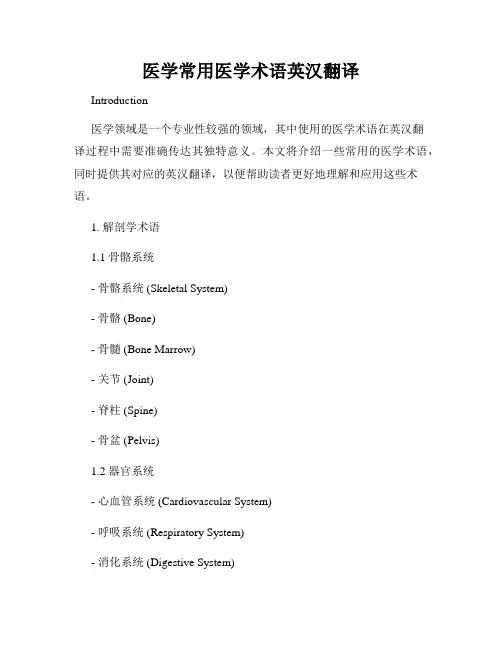
医学常用医学术语英汉翻译Introduction医学领域是一个专业性较强的领域,其中使用的医学术语在英汉翻译过程中需要准确传达其独特意义。
本文将介绍一些常用的医学术语,同时提供其对应的英汉翻译,以便帮助读者更好地理解和应用这些术语。
1. 解剖学术语1.1 骨骼系统- 骨骼系统 (Skeletal System)- 骨骼 (Bone)- 骨髓 (Bone Marrow)- 关节 (Joint)- 脊柱 (Spine)- 骨盆 (Pelvis)1.2 器官系统- 心血管系统 (Cardiovascular System)- 呼吸系统 (Respiratory System)- 消化系统 (Digestive System)- 泌尿系统 (Urinary System)- 内分泌系统 (Endocrine System) - 生殖系统 (Reproductive System) 2. 病理学术语2.1 常见疾病- 癌症 (Cancer)- 糖尿病 (Diabetes)- 炎症 (Inflammation)- 高血压 (Hypertension)- 心脏病 (Heart Disease)- 中风 (Stroke)2.2 疾病症状- 发烧 (Fever)- 头痛 (Headache)- 咳嗽 (Cough)- 呕吐 (Vomiting)- 腹痛 (Abdominal Pain)- 皮疹 (Rash)3. 诊断和治疗术语3.1 诊断方法- X光检查 (X-ray Examination)- 血液检查 (Blood Test)- 超声检查 (Ultrasound Examination) - 核磁共振 (MRI)- 病理检查 (Pathological Examination) - 活组织检查 (Biopsy)3.2 治疗方法- 药物治疗 (Medication)- 手术治疗 (Surgery)- 放疗 (Radiation Therapy)- 化疗 (Chemotherapy)- 康复治疗 (Rehabilitation)- 心理治疗 (Psychological Therapy) 4. 医学专业术语4.1 医生职称- 医生 (Doctor)- 护士 (Nurse)- 外科医生 (Surgeon)- 药剂师 (Pharmacist)- 麻醉师 (Anesthesiologist)- 放射科医生 (Radiologist)4.2 医学设备- 血压计 (Blood Pressure Monitor)- 听诊器 (Stethoscope)- 手术刀 (Surgical Knife)- 注射器 (Syringe)- 手术灯 (Operating Light)- 心电图机 (Electrocardiograph)Conclusion通过本文介绍的医学术语英汉翻译,读者可以更好地理解和运用这些术语。
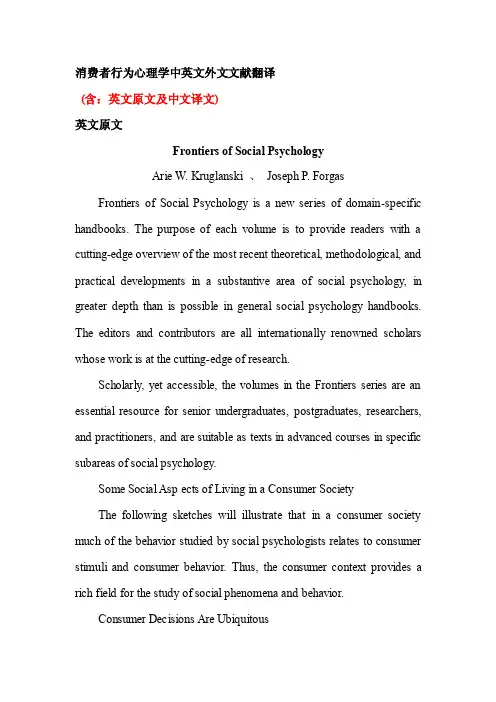
消费者行为心理学中英文外文文献翻译(含:英文原文及中文译文)英文原文Frontiers of Social PsychologyArie W. Kruglanski 、Joseph P. ForgasFrontiers of Social Psychology is a new series of domain-specific handbooks. The purpose of each volume is to provide readers with a cutting-edge overview of the most recent theoretical, methodological, and practical developments in a substantive area of social psychology, in greater depth than is possible in general social psychology handbooks. The editors and contributors are all internationally renowned scholars whose work is at the cutting-edge of research.Scholarly, yet accessible, the volumes in the Frontiers series are an essential resource for senior undergraduates, postgraduates, researchers, and practitioners, and are suitable as texts in advanced courses in specific subareas of social psychology.Some Social Asp ects of Living in a Consumer SocietyThe following sketches will illustrate that in a consumer society much of the behavior studied by social psychologists relates to consumer stimuli and consumer behavior. Thus, the consumer context provides a rich field for the study of social phenomena and behavior.Consumer Decisions Are UbiquitousWhether we are in the supermarket or not, we are constantly making consumer decisions. We enroll in gyms, use our frequent-flyer miles for a vacation resort, buy health care, choose a restaurant, skip dessert for a healthier lifestyle. In fact, most of our daily decisions do not involve existential decisions such as whom to marry or whether to have children or not, but whether to have tea or coffee, use our credit card or pay cash, or other seemingly trivial decisions. Moreover, many of our daily (consumer) behaviors do not even require intentional decisions. Rather, they may be habitual, such as switching to CNN to get the news or accessing Google when looking up some information. A typical day of a typical person is filled with countless minor consumer decisions or the consequences of previous decisions, starting with the brand of toothpaste in the morning to choosing a movie after work.Consumer Choices Fulfill a Social-Identity FunctionAlthough for most people being a consumer may not be central to their identity, many of their consumer decisions are nevertheless highly identity-relevant insofar as they correspond to a larger set of values and beliefs and express important aspects of the self. Eating a vegetarian diet because one does not want to endorse cruelty to animals and boycotting clothes potentially made by child laborers are some examples. Some people buy a Prius out of environmental concerns; others boycott Japanese cars —such as the Prius —in order to help the local carindustry. In this respect, even the choice between Coke and Pepsi is not necessarily trivial. People who cannot discriminate Coke from Pepsi in a blind test, or who prefer Pepsi, may nevertheless adhere to Coke as a cultural icon. Attempts to change the formula of Coke met with angry protests and opposition. Clearly, consumer products and brands do not only fulfill utilitarian needs (Olson & Mayo, 2000; Shavitt, 1990). In a world of oversupply and differentiating brands, many consumers choose brands in order to express their personality or to affiliate themselves with desired others. They do not simply use a Mac; they are Mac users, and switching to another brand of PC would be akin to treason. From soft drinks to computers, brands may become an ideology. People may also perceive of products as extended selves (Belk, 1988); for example, they may identify with their cars just as they do with pets. Likewise, brands may define social groups. The Harley-Davidson Club is a legendary example; an Internet search revealed clubs for almost every car brand and model. In my hometown, I found a V olkswagen New Beetle Club whose stated purpose is to cultivate contacts between New Beetle Drivers by organizing social events (among others, a visit to a car cemetery). On the road, drivers of the same car model often greet each other. Apparently, driving the same model is sufficient to establish social closeness. Brands, products, and consumption habits not only help to establish social connectivity but also serve as status symbols, defining vertical andhorizontal social boundaries. By using particular brands or consuming specific products, people can express a certain lifestyle or attempt to convey a particular social impression. Subscribing to the opera conveys one’s social position just as going to a monster truck race does. Whether your choice of drink is wine or beer, cappuccino or herbal tea, your order expresses more than merely your taste in beverages.Consumer Choices Affect Social PerceptionGiven that brands and products are part of social expression, it is not surprising that people are judged by the brands and products they use. In particular, products of a social-identity function are used as bases for inferences about a target’s personality traits (Shavitt & Nelson, 2000). Likewise, smoking, food choice and amount of food intake have all been shown to affect social impressions. Depending on the subculture of the perceiver (age, country), different personality traits are assumed in smokers compared with nonsmokers (e.g., Cooper & Kohn, 1989; Jones & Carroll, 1998). Various studies found that eaters of a healthier diet are perceived as more feminine and in general judged more favorably than eaters of unhealthy foods (for a review see V artanian, Herman, & Polivy, 2007). Arguing that a Pepsi drinker is to a Coke drinker what a Capulet was to a Montague is, of course, an exaggeration, but clearly brands may distinguish ingroup from out-group members. Possibly this is most extreme among teenagers, where the brand of jeans is perceived todetermine coolness and popularity. Nevertheless, the phenomenon is not limited to teen culture, as testified by the previous examples of social communities defined by shared brands. In sum, from wet versus dry shaving to driving a Porsche versus a Smart, consumer behavior is used as a cue in person perception. Most likely, such cues also manifest in behavior toward these consumers. Physical attacks on women who wear fur are a most extreme example.Affective Consequences of Consumer BehaviorObviously, consumption and the use of products and services may give pleasure and satisfaction or displeasure and dissatisfaction. People may experience joy from wearing a new sweater or suffer emotional consequences when products or services fail or cause inconvenience. Product use is only one source of affective consumer experiences. The mere act of choosing and acquisition is another. People enjoy or dislike the experience of shopping. They may take pleasure from the freedom of simply choosing between different options (e.g., Botti & Iyengar, 2004), feel overwhelmed and confused by an abundance of options (e.g., Huffman & Kahn, 1998), or feel frustrated by a limited assortment that does not meet their particular needs (e.g., Chernev, 2003). They may experience gratification and a boost in self-esteem from the fact that they can afford a particular consumer lifestyle or grudge the fact that they cannot. Many daily sources of affective experiences involve consumerbehavior in one way or another.The Consumer Context Provides Unique Social InteractionsGranted, we rarely form deep and meaningful relationships with our hairdressers and waiters. Still, the consumer context affords many social interactions over a day. Again, these interactions— even if brief— may constitute a source of affective experiences. The smile of the barista, the compliment from the shop-assistant, and the friendly help from the concierge are just a few examples of how such consumerrelated interactions may make us feel good, worthy, and valued, whereas snappy and rude responses have the opposite effect. Besides, the social roles defined by the consumer context may provide unique opportunities for particular behaviors, interactions, and experiences not inherent in other roles. Being a client or customer makes one expect respect, courtesy, and attendance to one’s needs. For some, this may be the only role in their life that gives them a limited sense of being in charge and having others meet their demands. To give another example, complaining is a form of social interaction that mostly takes place within the consumer context. A search for ―complaint behavior‖ in the PsycI NFO database found that 34 out of 50 entries were studies from the consumer context. (The rest mostly related to health care, which may to some extent also be viewed as consumer context.) Given the importance of the consumer context to social experiences and interactions, it provides a prime opportunity forstudying these social behaviors.•How consumers think, feel, reason, and the psychology of screening for different items (such as brands, products); • Consumer behavior when they shop or make other marketing decisions;•Limits in consumer knowledge or access to information affect decisions and marketing outcomes;•How can marketers adapt and improve their marketing competitiveness and marketing strategies to attract consumers more efficiently?Bergi gives an official definition of consumer behavior: the process and the activities people perform when they research, select, purchase, use, evaluate, and deal with products and services in order to meet their needs. The behavior occurs in a group or an organization where individuals or individuals appear in this context. Consumer behavior includes using and handling products and studying how products are bought. The use of products is generally of great interest to marketers because it may affect how a product is in the best position or how we can encourage increased consumption.The Nicosia model focuses on the relationship between the company and its potential customers. The company communicates with consumers through its marketing messages or advertisements and consumers' reactions to the information they want to buy. Seeing this pattern, we willfind that companies and consumers are interconnected. Companies want to influence consumers. Consumers influence company decisions through their decisions.Consumer sentiment refers to a unique set of emotional reactions to the use of or eliciting a consumer experience in the product, a unique class or relationship of the emotional experience described and expressed (such as joy, anger and fear), such as the structural dimensions of the emotional category or pleasant/unpleasant, Relax/action, or calm/excited. Goods and services are often accompanied by emotional reactions (such as the fear caused by watching a horror movie). Emotional values are often associated with aesthetic choices (such as religion, reason). However, more material and utilitarian products also seem to have emotional value. For example, some foods cause childhood experiences and feel comfortable with them. Izad (1977) developed a method of emotional experience and introduced basic emotions. He uses ten words to distinguish the basic types of emotions: interest, joy, surprise, sadness, anger, disgust, contempt, fear, shame, and guilt. This method has been widely used by consumer research.In order to implement the interpersonal and personal construction in this framework, we use the concept of self-awareness to express the influence of consumer response on society. Self-awareness is defined as the individual's consistent trend to focus directly on inward or outward.This theory identifies two different types of people with self-consciousness. The open self-conscious person pays special attention to other people's views on their outside. The private self-conscious person pays more attention to their inner thoughts and feelings. In this case, we assume that the reputation of consumption may be different based on sensitivity to other people. This proposal is also consistent with previous research. It shows that people with different personal behaviors depend on their sensitivity to interpersonal influences. Dubois and Dikena emphasized that "we believe that the analysis of the direct relationship between consumers and brands is a key to improving understanding of such a market." This original assumption is that of private or The value of the open superior product comes from the inherent social status of these objects. Many existing studies emphasize the role of the role played in the exchange of information about their owners and social relationships.中文译文社会心理学前沿艾瑞·克鲁格兰斯基,约瑟夫·弗加斯社会心理学的前沿是一个新的领域专用手册系列。

Cultural bias inpsychologicaltheory and researchEXAMPLESOF CULTURAL BIAS IN PSYCHOLOGYSocial influence - Cross-cultural replications of obedience and conformity studies have revealed wide differences in resistance to influence. Interpersonal relationships – culture bias in Western research on this topic, is revealed by its focus on●brief, new acquaintance, rather thanlong term, kin relationships.●the idea that marriage on the basisof romantic love is more desirablethan on the basis of companionatelove.Helping behavior –Western economic theories on the costs and rewards of helping behavior may not be suitable for other culture.Abnormality –The increased diagnosis of mental disorder in immigrants may reflect prejudice or misunderstanding by a native diagnoser.心理学理论和研究中的文化偏见心理学中文化偏见举例社会影响–对顺从和服从的跨文化研究揭示了在抗拒影响方面存在广泛的差异。
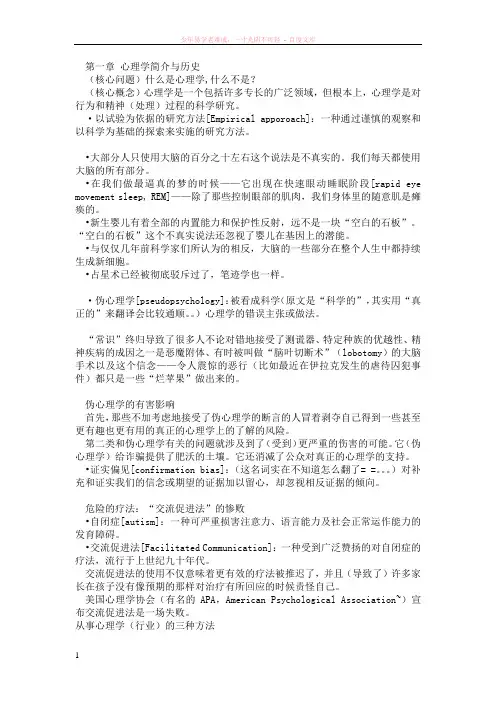
第一章心理学简介与历史(核心问题)什么是心理学,什么不是?(核心概念)心理学是一个包括许多专长的广泛领域,但根本上,心理学是对行为和精神(处理)过程的科学研究。
·以试验为依据的研究方法[Empirical apporoach]:一种通过谨慎的观察和以科学为基础的探索来实施的研究方法。
•大部分人只使用大脑的百分之十左右这个说法是不真实的。
我们每天都使用大脑的所有部分。
•在我们做最逼真的梦的时候——它出现在快速眼动睡眠阶段[rapid eye movement sleep, REM]——除了那些控制眼部的肌肉,我们身体里的随意肌是瘫痪的。
•新生婴儿有着全部的内置能力和保护性反射,远不是一块“空白的石板”。
“空白的石板”这个不真实说法还忽视了婴儿在基因上的潜能。
•与仅仅几年前科学家们所认为的相反,大脑的一些部分在整个人生中都持续生成新细胞。
•占星术已经被彻底驳斥过了,笔迹学也一样。
·伪心理学[pseudopsychology]:被看成科学(原文是“科学的”,其实用“真正的”来翻译会比较通顺。
)心理学的错误主张或做法。
“常识”终归导致了很多人不论对错地接受了测谎器、特定种族的优越性、精神疾病的成因之一是恶魔附体、有时被叫做“脑叶切断术”(lobotomy)的大脑手术以及这个信念——令人震惊的恶行(比如最近在伊拉克发生的虐待囚犯事件)都只是一些“烂苹果”做出来的。
伪心理学的有害影响首先,那些不加考虑地接受了伪心理学的断言的人冒着剥夺自己得到一些甚至更有趣也更有用的真正的心理学上的了解的风险。
第二类和伪心理学有关的问题就涉及到了(受到)更严重的伤害的可能。
它(伪心理学)给诈骗提供了肥沃的土壤。
它还消减了公众对真正的心理学的支持。
•证实偏见[confirmation bias]:(这名词实在不知道怎么翻了= =。
)对补充和证实我们的信念或期望的证据加以留心,却忽视相反证据的倾向。
危险的疗法:“交流促进法”的惨败•自闭症[autism]:一种可严重损害注意力、语言能力及社会正常运作能力的发育障碍。

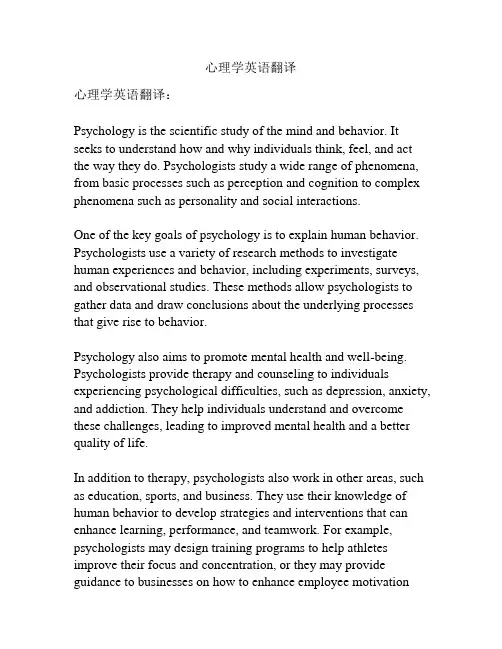
心理学英语翻译心理学英语翻译:Psychology is the scientific study of the mind and behavior. It seeks to understand how and why individuals think, feel, and act the way they do. Psychologists study a wide range of phenomena, from basic processes such as perception and cognition to complex phenomena such as personality and social interactions.One of the key goals of psychology is to explain human behavior. Psychologists use a variety of research methods to investigate human experiences and behavior, including experiments, surveys, and observational studies. These methods allow psychologists to gather data and draw conclusions about the underlying processes that give rise to behavior.Psychology also aims to promote mental health and well-being. Psychologists provide therapy and counseling to individuals experiencing psychological difficulties, such as depression, anxiety, and addiction. They help individuals understand and overcome these challenges, leading to improved mental health and a better quality of life.In addition to therapy, psychologists also work in other areas, such as education, sports, and business. They use their knowledge of human behavior to develop strategies and interventions that can enhance learning, performance, and teamwork. For example, psychologists may design training programs to help athletes improve their focus and concentration, or they may provide guidance to businesses on how to enhance employee motivationand productivity.Psychology is a multidisciplinary field that draws on various scientific disciplines, including biology, chemistry, and neuroscience. It also incorporates theories and concepts from other social sciences, such as sociology and anthropology. By integrating knowledge from these different fields, psychologists are able to gain a comprehensive understanding of human behavior. Overall, psychology is a diverse and dynamic field that has a profound impact on our understanding of ourselves and the world around us. It helps us make sense of our thoughts, emotions, and actions, and provides valuable insights into how we can live fulfilling and meaningful lives.。


收稿日期:2014-7-1;修改稿:2014-7-171. 引言英国语言学家M i c h a e l H o e y 在L e x i c a l Priming: A New Theory of Words and Language(2005)一书中提出了Lexical Priming 理论,该理论在我国语言学界产生了一定的反响,一些学者先后发表了有关该理论的文献综述和学术论文。
在这些中文文献中,对于该理论的关键词“priming ”及其原形动词“prime ”和过去分词“primed ”的中文对等词最常采用的是“触发”和“启动”,因此,lexical priming 被译成了“词汇触发”(如:李力,2006)和“词汇启动”(如:吕长竑,2010;黄立波、王克非,2011)。
通过对照H o e y 的原文,笔者发现,在有关lexical priming 的一些中文文献中,“触发”或“启动”尚不能准确和忠实地表达Hoey 理论中p r i m i n g 的本意。
因此,笔者根据H o e y 的有关文章和著作以及向Hoey 教授本人的直接请教和交流,并检索有关文献资料,对l e x i c a l priming 理论中priming 的含义和该术语的中译进行了分析和讨论,并提出了对于该词的中译建议,以期引起学术界的关注和讨论,使这一理论得到更好的理解和交流,并规范该术语的中文翻译。
2. Priming 出现在相关文献中的中文对等词早在Hoey (2005)提出Lexical Priming 理论之前的30多年中,priming 作为一个术语已被广泛应用于心理学和认知科学上,它指“先前的某个刺激或事件如何使人对于随后的某个刺激作出反应的效应。
”(Schneider et al., 2005)。
在中文文献中,通常将与心理学相关的“priming ”译为“启动”。
启动过程(priming procedure )在认知心理学上用来探索记忆网络模式内的信息结构和表达。
自传体记忆系统在消极情绪体验中:如何从过去的记忆中得出目前的感受The Role of Autobiographical Memory Networks in the Experience of Negative Emotions: How Our Remembered Past Elicits Our Current FeelingsFrederick L. Philippe and Richard Koestner McGill University Serge Lecours, Genevieve Beaulieu-Pelletier,and Katy Bois Universite´ de Montre´al摘要本研究考察了在消极情绪体验中,自传体记忆网络所起到的作用。
两个实验结果发现,自传体记忆及其相关的记忆系统在消极情绪体验中的作用是活跃而明显的。
此外,与自我决定理论一致,对能力、自主及人际关系的心理需要的受挫,是自传体记忆影响消极情绪体验的关键环节。
研究一揭示,在与损失主题相关的自传体记忆系统中,心理需要的受挫与抑郁情绪正相关,而非其他的消极情绪。
研究二以一个预测设计揭示,相对于对待不公的情绪,愤怒相关及内疚相关的自传体记忆网络二者在情景愤怒上的差别更为显著。
所有的结果都是在控制神经质(研究一、二)和自我控制(研究二)及效价(研究一)和情绪(研究二)的基础之上,通过测量自传体记忆网络而得出的。
这些结果呈现了需要受挫在自传体记忆网络中持续的具有情感意义的表达。
关键词自传体记忆,消极情绪,需要受挫,记忆网络,自我决定理论尽管记忆与情绪的关系很久以来为研究者所兴趣的论题,但众多研究者主要关心的是——情绪怎样影响情绪。
例如,上世纪80年代到90年代间的研究考察了个体当前的情绪如何影响了情绪一致性记忆(如,Bower & Cohen, 1982; Clore & Parrott, 1991),或者情绪记忆的效果优于中性记忆的方式(Heuer & Reisberg,1990)。
第7页起源和历史·行为主义的研究方法受经验主义和自然科学的影响.其中,经验主义强调人类出生时犹如一块白纸或白板,所以知识是通过感觉通道从环境中获得的,自然科学则强调研究方法的科学性和客观性。
·1913年,华生写了一篇名为《行为主义者心目中的心理学》的文章,从此他引发了行为主义的浪潮,这篇文章中也表明了行为主义的主要原理和假设。
华生、桑代克、斯金纳等行为主义学家根据早年巴甫洛夫的工作而开始发展学习理论,比如:经典和操作条件反射,他们试图用学习理论从本质上解释所有行为。
·行为主义研究方法一直主导着实验心理学,直到20世界初50世界末。
动物行为学家和认知心理学家开始越来越多地批判它的假设和研究方法,为了提供更加真实的关于学习是如何发生的解释,行为主义被一些心理学家改变,rubies班杜拉和他的社会学习理论.华生:给我一打健康的婴儿,让我在我的特殊世界中教养,那么我可担保,在这十几个婴儿之中随机拿出一个都可以训练他成为任何一种我所选类型的专家。
可以是医生、律师、甚至也可以是一个乞丐或小偷。
理论假设行为主义者认为:·多数行为是后天从环境中习得的,行为主义者在天性还是教育的辩论中选择了教育一方,他们还认为:a.心理学应该区分学习的规律和结果;b.行为是由环境决定的,因为我们只不过是我们过去所有学习经验的整合,而自由意志则是幻觉(错误的)·心理学如果要成为一门客观性科学,就应该只研究可观察到的行为,而不是意识;因为我们是无法看清他人意识的;并且如果我们去询问他人的想法,他们就可能说谎,或者不知道,或者甚至出错。
调查研究方法行为主义者采用的是一种完全研究一般规律的方法,他们用严谨的实验室实验,并且通常是训练像老鼠、鸽子这样的动物.行为主义者训练动物是由于他们相信:1、学习的规律是有普遍性的2、人和动物之间只有一定数量的不同而已3、训练动物会更加方便,也是很实用且合乎道德的阐释内容行为主义者的这些有关学习规律的发现可以有力地应用在解释行为的许多方面上,比如:·语言获得,eg:斯金纳的理论·道德发展,eg:条件控制下关于愧疚和良心的情绪反应·吸引力,eg:Byrne&clor的强化影响模型·变态,eg:恐怖症的经典条件反射及其治疗还有攻击行为、偏见、性别角色鉴定等具体应用行为主义学习理论的研究方法已经出教育中的实践应用(比如,程式化学习)和那些痛苦的行为障碍的治疗(比如,针对恐怖症的系统脱敏、自闭症的行为塑造以及被收容的病人的代币制度)·操作条件反射原理被应用于训练动物以完场任务,他们训练了有马戏团动物还有导向犬.·华生将行为主义理论同时应用于抚养儿童以及广告业,于此同时斯金纳则在他的书中提出了许多关于社会中大范围的行为塑造的建议,比如《超越自由与尊严》和《沃尔登第二》。
西医疼痛科术语英文翻译以下是常见的西医疼痛科术语英文翻译:1. 疼痛科:Pain Management Department2. 疼痛评估:Pain Assessment3. 疼痛分类:Pain Classification4. 慢性疼痛:Chronic Pain5. 急性疼痛:Acute Pain6. 癌痛:Cancer Pain7. 神经痛:Neuropathic Pain8. 关节痛:Joint Pain9. 头痛:Headache10. 偏头痛:Migraine11. 肌痛:Myalgia12. 疼痛管理:Pain Management13. 药物治疗:Pharmacological Therapies14. 非药物治疗:Non-pharmacological Therapies15. 物理治疗:Physical Therapies16. 神经调节治疗:Neuromodulation Therapies17. 心理治疗:Psychological Therapies18. 针灸治疗:Acupuncture Therapy19. 微创手术:Minimally Invasive Surgery20. 脊柱外科手术:Spinal Surgery21. 关节镜手术:Arthroscopic Surgery22. 硬膜外注射治疗:Epidural Injection Therapy23. 神经阻滞治疗:Nerve Block Therapies24. 射频消融治疗:Radiofrequency Ablation Therapy25. 疼痛教育:Pain Education26. 疼痛康复:Pain Rehabilitation27. 疼痛护理:Pain Nursing28. 疼痛患者自我管理:Self-management for Pain Patients29. 疼痛管理药物经济学:Pharmacoeconomics of Pain Management30. 疼痛管理伦理学:Ethics of Pain Management31. 疼痛管理法律问题:Legal Issues in Pain Management32. 疼痛管理心理学:Psychology of Pain Management33. 疼痛管理多学科合作:Multidisciplinary Collaborations in Pain Management34. 疼痛管理临床实践指南:Clinical Practice Guidelines for Pain Management35. 阿片类药物耐受性与成瘾性管理:Opioid Tolerance and Addiction Management36. 药物治疗安全性监测与管理:Drug Safety Monitoring and Management in Pain Management37. 非药物治疗有效性评估与实施:Evaluation and Implementation of Non-pharmacological Interventions for Pain Management38. 慢性疼痛的预防与管理策略:Prevention and Management Strategies for Chronic Pain39. 癌痛的多学科综合治疗与管理:Multidisciplinary Comprehensive Cancer PainManagement40. 神经痛的治疗与管理策略:Treatment and Management Strategies for Neuropathic Pain41. 关节痛的物理治疗与管理策略:Physical Therapies and Management Strategies for Joint Pain42. 头痛的诊断与治疗策略:Diagnostic and Therapeutic Strategies for Headache Disorders43. 肌痛的非药物治疗与管理策略:Non-pharmacological Interventions and Management Strategies for Myalgia44. 疼痛管理的患者教育与支持系统建设:Patient Education and Support System Development in Pain Management45. 基于互联网的远程疼痛管理解决方案:Internet-based Remote Pain Management Solutions46. 人工智能在疼痛管理中的应用与前景:Application and Prospects of Artificial Intelligence in Pain Management47. 社会心理因素对疼痛感知与耐受性的影响研究:Studies on the Impact of Psychosocial Factors on Pain Perception and Tolerance48. 个体化疼痛治疗方案的研究与实践进展:Research and Practical Advances in Personalized Pain Management Strategies49. 儿童与老年人的特殊疼痛问题及管理策略研究:Studies on Special Pain Problems and Management Strategies in Children and Elderly Adults50. 国际疼痛管理领域的最新研究动态与合作项目:Recent Research Developments and Collaborative Projects in International Pain Management。
《《通过接纳与承诺疗法抗癌》(节选)英汉翻译实践报告》篇一《通过接纳与承诺疗法抗癌》英汉翻译实践报告(节选)一、引言本篇翻译实践报告旨在探讨接纳与承诺疗法在抗癌过程中的重要性,通过具体的实践案例分析,将这一治疗方法的核心内容与实际运用相结合,进行详细的英汉翻译实践。
报告的目的是提高读者对接纳与承诺疗法的认识,为相关领域的翻译工作提供参考。
二、原作介绍本篇翻译实践的原作主要介绍了接纳与承诺疗法(ACT)在抗癌过程中的运用。
ACT是一种心理治疗方法,强调接受无法改变的事实并承诺为改善自己的生活而努力。
在癌症治疗过程中,这种治疗方法能帮助患者调整心态,提高应对能力,积极面对治疗带来的压力。
三、翻译过程分析在翻译过程中,首先要充分理解原文内容,明确接纳与承诺疗法的核心思想及其在抗癌过程中的作用。
接着,根据英语句子的结构特点,灵活运用各种翻译技巧,如转换语序、增译、减译等,使译文更加符合中文表达习惯。
同时,注重保持原文的语义连贯性和逻辑性,确保译文的准确性和流畅性。
四、重点难点解析在翻译过程中,遇到了以下重点难点:1. 心理专业术语的翻译:如“接受”(acceptance)和“承诺”(commitment)等词汇在心理学领域具有特定的含义。
在翻译过程中,需要准确理解这些术语的内涵,并选择恰当的词汇进行表达。
2. 跨文化差异的处理:由于中西方文化差异较大,在翻译过程中需要充分考虑目标读者的文化背景和思维方式,使译文更加贴近目标读者的阅读习惯。
3. 原文逻辑关系的梳理:由于原文句子结构较为复杂,需要仔细分析原文的逻辑关系,确保译文的连贯性和逻辑性。
针对上述问题,我们在翻译时采取了以下措施:首先,针对心理专业术语的翻译,我们通过查阅相关心理学资料和文献,准确理解这些术语的内涵,并选择最恰当的中文词汇进行表达。
其次,针对跨文化差异的处理,我们进行了充分的调研,了解目标读者的文化背景和思维方式。
在翻译过程中,我们尽可能保留原文的文化特色,同时用更加贴近目标读者阅读习惯的中文进行表达。
心理学名词术语1.物质依赖物质依赖,是指长期滥用某种物质后,产生一种心理上与躯体上的强烈而不能克制寻觅该种物质的状态,冀以体验重复使用该物质的心理快感,同时避免戒断的躯体不适。
前者称为心理依赖,后者称为躯体依赖。
2.心电感应心电感应是人体特异功能所出现的超越五官感知不可思议的能力。
具有这些能力的人士有些是天生的,有些是经过气功修练到高深境界后所出现的,也有些是大难不死,如生重病或出意外之后出现的。
基本上它是一种人类潜在的能力,正式的名称应该定为“人体潜能”。
3.感觉记忆瞬时记忆亦称“感觉记忆”,记忆系统的一种,刺激作用于感觉器官所引起的短暂记忆。
通常是指1秒钟左右的时间,即刚刚感觉到所注意的信息时间(有人把这种记忆叫感觉记忆),瞬时记忆时间极短,大量的、被注意到的信息很容易消失,能够记住的东西才进入短时记忆。
4.心理动力是精神分析学的一个概念,指人类一切精神活动的内在驱动力。
弗洛伊德精神分析学认为,存在于无意识中的性本能是人的心理的基本动力,是摆布个人命运、决定社会发展的永恒力量。
5.冥想冥想是翻译过来的一个单词,在英文里,它指的是禅修的意思,是瑜伽实现入定的一项技法和途径,把心、意、灵完全专注在原始之初之中;最终目的在于把人引导到解脱的境界。
瑜伽者通过冥想来制服心灵,并超脱物质欲念;感受到和原始动因直接沟通。
通过简单练习冥想,即可帮助人们告别负面情绪,重新掌控生活。
6.催眠催眠是指催眠师向被试提供暗示,以唤醒他的某些特殊经历和特定行为。
许多心理学家认为,催眠与其他一般状态是相似的,包括放松、全神贯注和联想。
在催眠状态下,一个人可能经历“在感知、思维、记忆和行为上的一些改变”,包括暂时的麻痹、幻觉和忘记“对催眠术医师的暗示做出反应”。
7.超感知觉超感官知觉简称ESP,心理学研究范畴。
是指不凭借感官信息而对外界事物获得知觉经验的现象。
心灵学者对超感官知觉的研究主要集中在:(1)心电感应或传心术,即两人在远距离下传递思想情感的能力;(2)灵感,即在无直接感觉下产生对具体事物的知觉现象,如可看到封闭在不透明容器内的东西;(3)预知,可预先知道尚未发生的事情或别人的思想;(4)心灵致动,即以心灵的力量来影响或控制物质对象的能力。
Expertise及相关术语的译名商榷作者:王少爽来源:《中国科技术语》2011年第01期摘要:术语对于一个学科的发展具有重要意义。
通过追溯“expertise”及相关认知心理学术语的源起,分析其现有汉语译名的不足,认为外来术语汉译应遵循四项原则:准确性、专业性、可读性和一致性。
据此,对该术语及相关术语的译名进行商榷论证,进而探讨四原则的内涵与相互关系。
关键词:术语,汉译,原则,expertise中图分类号:H059;H083;N04 文献标识码:A 文章编号:1673-8578(2011)01-0025-06On the Chinese Translation of “Expertise” and Related Terms—Exploring Principles for Translating Foreign Terms into ChineseWANG ShaoshuangAbstract: Terminology constitutes a significant part in the development of a discipline. This paper probes into the origin of expertise and some related terms of cognitive psychology, analyzes the inadequacy in their existing Chinese translations, and thus argues for four principles for translating foreign terms into Chinese, i.e., accuracy, technicality, readability and consistency. On this basis, it goes on to elaborate on the proper Chinese translations of “expertise” and related terms in order to explore the meaning of these four principles as well as their interconnections.Keywords: terminology, Chinese translation, principles, expertise一引言术语是一个学科学术话语体系中的专业词汇集,是该学科理论思想的核心体现和理论发展的特殊标记。
感觉记忆(SM)—sensory memory短期记忆(STM)—short-term M。
长期记忆(LTM)—long-term memory复诵——rehearsal预示(激发)——priming童年失忆症——childhood amnesia视觉编码(表征)——visualcode(representation)听觉编码—acoustic code运作记忆——working memory语意性知识—semantic knowledge记忆扫瞄程序—memory scanning procedure竭尽式扫瞄程序-exhaustive S.P。
自我终止式扫瞄—self-terminated S。
程序性知识—procedural knowledge命题(陈述)性知识——propositional(declarative)knowl edge情节(轶事)性知识—episodic K。
讯息处理深度—depth of processing精致化处理—elaboration登录特殊性—coding specificity记忆术—mnemonic位置记忆法—method of loci字钩法—peg word(线)探索(测)(激发)字—prime关键词——key word命题思考——propositional thought心像思考——imaginal thought行动思考——motoric thought概念——concept原型——prototype属性——property特征——feature范例策略——exemplar strategy语言相对性(假说)—linguisticrelativity th。
音素——phoneme词素——morpheme(字词的)外延与内涵意义—denotative & connotative meaning(句子的)表层与深层结构—surface& deep structure语意分析法——semanticdifferential全句语言—holophrastic speech过度延伸——over-extension电报式语言—telegraphic speech关键期——critical period差异减缩法——differencereduction方法目的分析——means-endsanalysis倒推——working backward动机——motive自由意志——free will决定论——determinism本能——instinct种属特有行为——species specific驱力——drive诱因——incentive驱力减低说——drive reductionth。
恒定状态(作用)—homeostasis原级与次级动机—primary &secondary M。
功能独立—functional autonomy下视丘侧部(LH)—lateralhypothalamus脂肪细胞说——fat-cell theory。
下视丘腹中部(VMH)—ventromedialH定点论——set point th。
CCK───胆囊调节激素第一性征——primary sexcharacteristic第二性征——secondary sexcharacteristic自我效能期望—self-efficiencyexpectancy内在(发)动机—intrinsic motive外在(衍)动机—extrinsic motive成就需求——N. achievement需求层级—hierarchy of needs自我实现——self actualization冲突——conflict多项仪——polygraph肤电反应——GSR(认知)评估——(cognitiveappraisal)脸部回馈假说——facial feedbackhypothesis(生理)激发——arousal挫折-攻击假说——frustration-aggression hy。
替代学习——vicarious learning发展——development先天——nature后天——nurture成熟——maturation(视觉)偏好法——preferential method习惯法——habituation视觉悬崖——visual cliff剥夺或丰富(环境)——deprivation or enrichment of env。
基模——schema同化——assimilation调适——accommodation平衡——equilibrium感觉动作期——sensorimotor stage物体永久性——objective permanence运思前期——preoperational st。
保留概念——conservation道德现实主义——moral realism具体运思期——concrete operational形式运思期——formal operational st。
前俗例道德——pre-conventional moral俗例道德——conventional moral超俗例道德——post-conventional moral气质——temperament依附——attachment性别认定——gender identity性别配合——sex typing性蕾期——phallic stage恋亲冲突—Oedipal conflict认同——identification社会学习——social learning情结——complex性别恒定——gender constancy青年期——adolescence青春期—— -puberty第二性征——secondary sexcharacteristics认同危机——identity crisis定向统合——identity achievement早闭型统合——foreclosure未定型统合——moratorium迷失型统合——identity diffusion传承——generativity心理动力——psycho-dynamics心理分析——psychoanalysis行为论——behaviorism心理生物观——psycho-biologicalperspective认知——cognition临床心理学家-clinicalpsychologist谘商——counseling人因工程——human factorengineering组织——organization潜意识——unconsciousness完形心理学——Gestalt psychology感觉——sensation知觉——perception实验法——experimental method独变项——independent variable依变项——dependent V。
控制变项——control V。
生理——physiology条件化——conditioning学习——learning比较心理学——comparative psy。
发展——development社会心理学——social psy。
人格——personality心理计量学—psychometrics受试(者)——subject实验者预期效应—experimenterexpectancy effect双盲法——double—blind实地实验——field experiment相关——correlation调查——survey访谈——interview个案研究——case study观察——observation心理测验——psychological test纹理递变度——texture gradient注意——attention物体的组群——grouping of object型态辨识—pattern recognition形象-背景——figure-ground接近律——proximity相似律——similarity闭合律——closure连续律——continuity对称律——symmetry错觉——illusion幻觉——delusion恒常性——constancy大小——size形状——shape位置—— location单眼线索——monocular cue线性透视——linear- perspective 双眼线索——binocular cue深度——depth调节作用——accommodation重迭——superposition双眼融合——binocular fusion辐辏作用——convergence双眼像差——binocular disparity向度—— dimension自动效应——autokinetic effect运动视差——motion parallax诱发运动——induced motion闪光运动——stroboscopic motion上下文﹑脉络——context人工智能——artificial intelligence A.I。
脉络关系作用-context effect模板匹配——template matching整合分析法——analysis-by-synthesis丰富性——redundancy选择性——selective无意识的推论-unconsciousinferences运动后效——motion aftereffect特征侦测器—feature detector节省分数——savings外显与内隐记忆——explicit &implicit memory记忆广度——memory span组集——chunk序列位置效应——serial positioneffect起始效应——primacy effect新近效应——recency effect心(情)境依赖学习——state-dependent L。
无意义音节—nonsense syllable顺向干扰——proactiveinterference逆向干扰——retroactiveinterference闪光灯记忆——flashbulb memory动机性遗忘——motivatedforgetting器质性失忆症—organic amnesia阿兹海默症——Alzheimer'sdisease近事(顺向)失忆症—anterogradeamnesia旧事(逆向)失忆—retrograde A。
高沙可夫症候群—korsakoff'ssyndrome凝固理论—consolidation激发性——excitatory抑制性——inhibitory几何子——geons由上而下处理—up-down process由下而上处理——bottom-upprocess连结者模式——connectionistmodel联结失识症——associativeagnosia脸孔辨识困难症——prosopagnosia意识——conscious(ness)意识改变状态——altered statesof consciousness无意识——unconsciousness前意识——preconsciousness内省法——introspection边缘注意——peripheral attention多重人格——multiple personality午餐排队(鸡尾酒会)效应—lunchline(cocktail party) effect自动化历程——automatic process解离——dissociate解离认同失常——dissociativeidentity disorder快速眼动睡眠——REM dream非快速眼动睡眠—NREM dream神志清醒的梦——lucid dreaming失眠——insomnia显性与隐性梦——manifest & latern content心理活动性psychoactive冥想——meditation抗药性——tolerance戒断——withdrawal感觉剥夺——sensory deprivation物质滥用——substance abuse成瘾——physical addiction物质依赖——sub. dependence戒断症状——withdrawal symptom兴奋剂——stimulant幻觉(迷幻)剂——hallucinogen镇定剂——sedative抑制剂——depressant酒精中毒引起谵妄—delirium tremens麻醉剂——narcotic催眠——hypnosis催眠后暗示——posthypnotic suggestion催眠后失忆posthypnotic amnesia超心理学——parapsychology超感知觉extrasensory perception ESP心电感应——telepathy超感视——clairvoyance预知——precognition心理动力—psycokinesis PK受纳器——receptor绝对阈——absolute threshold 差异阈——difference threshold恰辨差——-JND韦伯律——Weber's law心理物理——psychophysical费雪纳定律——Fechner's law频率——frequency振幅——amplitude音频——pitch基音——fundamental tone倍音——overtone和谐音——harmonic音色——timbre白色噪音——white noise鼓膜——eardrum耳蜗——cochlea卵形窗—oval window圆形窗——round window前庭——vestibular sacs半规管——semicircular canals角膜——cornea水晶体——lens虹膜——iris瞳孔——pupil网膜——retina睫状肌——ciliary muscle调节作用——accommodation脊髓——spinal cord反射弧——reflex arc脑干——brain stem计算机轴性线断层扫描——CAT或CTPET——正子放射断层摄影MRI——磁共振显影延脑——medulla桥脑——pons小脑——cerebellum网状结构——reticular formationRAS——网状活化系统视丘——thalamus下视丘——hypothalamus大脑——cerebrum脑(下)垂体(腺)—pituitary gland脑半球——cerebral hemisphere皮质——cortex胼胝体——corpus callosum边缘系统——limbic system海马体——hippocampus杏仁核——amygdala中央沟——central fissure侧沟——lateral fissure脑叶——lobe同卵双生子——identical twins异卵双生子—fraternal twins古典制约——classicalconditioning操作制约——operant conditioning非制约刺激—(US unconditionedstimulus非制约反应—(UR)unconditioned R。